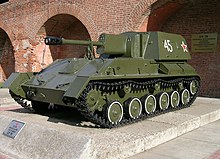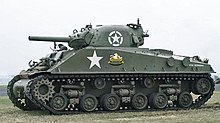Assault gun

Decommissioned Syrian Army StuG III assault gun with 75mm main armament. This example now resides at the Israeli Armored Corps Museum.
An assault gun is a form of self-propelled artillery[1] which utilizes an infantry support gun mounted on a motorized chassis, normally an armored fighting vehicle.[2] Assault guns are designed to provide direct fire support for infantry attacks, especially against other infantry or fortified positions.[3] The term is a literal translation of the German word Sturmgeschütz, which was applied to the first purpose-built assault gun, the StuG III, in 1940.[3]
Historically, the concept of assault guns was very similar to that of the infantry tank, as both were combat vehicles intended to accompany infantry formations into battle.[4] However, during World War II assault guns were more mobile than tanks and could be utilized as both direct and indirect fire artillery.[4] Although they could approximate the firepower of a tank, assault guns mostly fired high explosive shells at relatively low velocities, which were well suited for their role of knocking out hard points such as fortified positions and buildings.[4] They were not intended to be deployed as tank substitutes or dedicated tank destroyers.[4] Nevertheless, as the conflict progressed, the increasing proliferation of tanks on the battlefield forced many assault gun units to engage armor in defense of the infantry, and led to armies becoming more dependent on multipurpose designs which combined the traditionally separate roles of an assault gun and a tank destroyer.[5]
German and Soviet assault guns introduced during World War II usually carried their main armament in a fully enclosed casemate rather than a gun turret.[6] Although this limited the field of fire and traverse of the armament, it also had the advantage of a reduced silhouette and simplified the manufacturing process.[6] The United States never developed a purpose-built assault gun during the war, although it did modify preexisting armored fighting vehicles for that role, including the M4 Sherman and M5 Stuart tanks and the M3 Half-track.[7]
The assault gun concept was largely abandoned during the postwar era in favor of tanks or multipurpose tank destroyers attached to infantry formations which were also capable of providing direct fire support as needed. In the United States and most Western countries, the assault gun ceased to be recognized as a unique niche, with individual examples being classified either as a self-propelled howitzer or a tank.[8] The Soviet Union continued funding development of new assault guns as late as 1967, although few of its postwar designs were adopted in large numbers.[9] In Soviet and other Eastern European armies, the traditional assault gun was primarily superseded by tank destroyers such as the SU-100 capable of supporting either infantry or armor.[8]
Contents
1 History
1.1 World War II
1.2 Post-war use
2 See also
3 References
History
World War II

The Soviet SU-76 was easily constructed in small factories incapable of producing proper tanks.
Assault guns were primarily used during World War II by the forces of Nazi Germany and the Soviet Union. Early in the war, the Germans began to create makeshift assault guns by mounting their infantry support weapons on the bed of a truck or on obsolete tanks with the turret removed. Later in the war, both the Germans and the Soviets introduced fully armoured purpose-built assault guns into their arsenals.
Early on, the Soviets built the KV-2, a variant of the KV-1 heavy tank with a short-barrelled 152 mm howitzer mounted in an oversized turret. This was not a success in battle, and was replaced with a very successful series of turretless assault guns: the SU-76, SU-122, and the heavy SU-152, which were followed by the ISU-122 and ISU-152 on the new IS heavy tank chassis.

Sturmtiger in the Deutsches Panzermuseum at Munster, Lower Saxony.
The primary German assault gun was the Sturmgeschütz III (StuG III). At about the same time (March 1942) as the howitzer-like KwK 37 gun was dropped from the Panzer IV's use, its Sturmkanone equivalent in the StuG III up to that time, was likewise replaced with a longer-barreled, high-velocity dual-purpose 75mm gun that had also been derived from the successful PaK 40 anti-tank towed artillery piece. The Germans also built a number of other fully armoured turretless assault guns, including the StuG IV, StuIG 33B, Brummbär and Sturmtiger. The latter two were very heavy vehicles, and were built only in small quantities.
Battalions of assault guns, usually StuG IIIs, commonly replaced the intended panzer battalion in the German panzergrenadier divisions due to the chronic shortage of tanks, and were sometimes used as makeshifts even in the panzer divisions.[10] Independent battalions were also deployed as "stiffeners" for infantry divisions, and the StuG III's anti-tank capabilities bolstered dwindling tank numbers on the Eastern and Western fronts.

A preserved Sherman M4 (105).
US and UK forces also deployed vehicles designed for a close support role, but these were conventional tanks whose only significant modification was the replacement of the main gun with a howitzer. Two versions of the American Sherman tank were armed with the M4 105 mm howitzer, the M4(105) and the M4A3(105); these were designated assault guns in US usage of the term. The M8 Scott, based on the chassis of the M5 Stuart light tank, was also an assault cannon and carried a 75 mm short howitzer. The Churchill, Centaur and Cromwell tanks were all produced in versions armed with 95 mm howitzers: the Churchill Mark V and Mark VIII, the Centaur Mark IV and the Cromwell Mark VI. Earlier British tanks, such as the Crusader cruiser tank and the Matilda II Infantry tank were produced in versions armed with the 3-inch howitzer; the first versions of the Churchill tank also had this gun in a hull mounting. American tank destroyer units were often used in the assault gun role for infantry support.
The AVRE version of the Churchill Tank was armed with a Spigot mortar that fired a 40 lb (18 kg) HE-filled projectile (nicknamed the Flying Dustbin) 150 yards (140 m). Its task was to attack fortified positions such as bunkers at close range (see Hobart's Funnies).
Post-war use
In the post-WWII era, vehicles fitting into an "assault gun" category were developed as a light-weight, air-deployable, direct fire weapon for use with airborne troops. Current weapons were either based on jeeps or small tracked vehicles and the airborne troops thus always fought at a distinct disadvantage in terms of heavy weapons. The Soviet Union and the United States were the most attracted to the idea of providing this capability to traditionally light airborne forces. Their answers to the problem were similar, with the United States developing the M56 Scorpion and the Soviet Union developing the ASU-57, both essentially air-droppable light anti-tank guns.
The Soviets went on to develop an improved air-droppable assault gun, the ASU-85, which served through the 1980s, while their SU-100 remained in service with Communist countries, including Vietnam and Cuba, years after World War II. The US M56 and another armoured vehicle, the M50 Ontos, were to be the last of the more traditional assault guns in US service. Improvised arrangements such as M113 personnel carriers with recoilless rifles were quickly replaced by missile carrier vehicles in the anti-tank role.
The only vehicle with the qualities of an assault gun to be fielded after the removal of the M50 and M56 from service within the US military was the M551 Sheridan. The Sheridan's gun was a low-velocity weapon suitable in the assault role, but with the addition of the Shillelagh missile could double in the anti-tank role as well. The Sheridan, however, was not developed as an assault gun but as a light reconnaissance vehicle.
Currently there appears to be a move toward wheeled vehicles fitting a "tank destroyer" or "assault gun" role, such as the M1128 Mobile Gun System of the US Army, the Centauro Wheeled Tank Destroyer of the Italian and Spanish Armies, the Chinese anti-tank gun PTL-02 and ZBL08 assault gun, and the French AMX 10 RC heavy armoured car. While these vehicles might be useful in a direct fire role, none were developed with this specifically in mind, reminiscent of the use of tank destroyers by the US military in the assault gun role during World War II.
See also
- Armoured warfare
- Sturmgeschütz
- Tank destroyer
- Armoured fighting vehicle
- List of assault guns
- Self-propelled gun
References
^ Bull, Stephen. Encyclopedia of Military Technology and Innovation (2004 ed.). Greenwood Publishing Group. p. 229. ISBN 978-1573565578..mw-parser-output cite.citation{font-style:inherit}.mw-parser-output .citation q{quotes:"""""""'""'"}.mw-parser-output .citation .cs1-lock-free a{background:url("//upload.wikimedia.org/wikipedia/commons/thumb/6/65/Lock-green.svg/9px-Lock-green.svg.png")no-repeat;background-position:right .1em center}.mw-parser-output .citation .cs1-lock-limited a,.mw-parser-output .citation .cs1-lock-registration a{background:url("//upload.wikimedia.org/wikipedia/commons/thumb/d/d6/Lock-gray-alt-2.svg/9px-Lock-gray-alt-2.svg.png")no-repeat;background-position:right .1em center}.mw-parser-output .citation .cs1-lock-subscription a{background:url("//upload.wikimedia.org/wikipedia/commons/thumb/a/aa/Lock-red-alt-2.svg/9px-Lock-red-alt-2.svg.png")no-repeat;background-position:right .1em center}.mw-parser-output .cs1-subscription,.mw-parser-output .cs1-registration{color:#555}.mw-parser-output .cs1-subscription span,.mw-parser-output .cs1-registration span{border-bottom:1px dotted;cursor:help}.mw-parser-output .cs1-ws-icon a{background:url("//upload.wikimedia.org/wikipedia/commons/thumb/4/4c/Wikisource-logo.svg/12px-Wikisource-logo.svg.png")no-repeat;background-position:right .1em center}.mw-parser-output code.cs1-code{color:inherit;background:inherit;border:inherit;padding:inherit}.mw-parser-output .cs1-hidden-error{display:none;font-size:100%}.mw-parser-output .cs1-visible-error{font-size:100%}.mw-parser-output .cs1-maint{display:none;color:#33aa33;margin-left:0.3em}.mw-parser-output .cs1-subscription,.mw-parser-output .cs1-registration,.mw-parser-output .cs1-format{font-size:95%}.mw-parser-output .cs1-kern-left,.mw-parser-output .cs1-kern-wl-left{padding-left:0.2em}.mw-parser-output .cs1-kern-right,.mw-parser-output .cs1-kern-wl-right{padding-right:0.2em}
^ Bradford, James. International Encyclopedia of Military History (2006 ed.). Routledge Books. pp. 123–124. ISBN 978-0415936613.
^ ab Blennemann, Dirk (2003). Hitler's Army: The Evolution And Structure Of German Forces 1933-1945. Boston: Da Capo Press. pp. 66–63. ISBN 978-0306812606.
^ abcd Gudmundsson, Bruce (2004). On Armor. Westport, Connecticut: Prager Books. pp. 114–126. ISBN 978-0812216202.
^ Tucker-Jones, Anthony (2016). German Assault Guns and Tank Destroyers 1940 - 1945: Rare Photographs from Wartime Archives. Barnsley, South Yorkshire: Pen & Sword Books, Ltd. p. 114. ISBN 978-1473845992.
^ ab Levine, Mark (2000). D-Day to Berlin: The Northwest Europe Campaign, 1944-45. Mechanicsburg: Stackpole Books. pp. 21–22. ISBN 978-0811733861.
^ Gabel, Christopher; Estes, Kenneth (August 1999). Hoffman, George; Starry, Donn, eds. Camp Colt to Desert Storm: The History of U.S. Armored Forces. Lexington, Kentucky: University Press of Kentucky. pp. 149–156, 479–481. ISBN 978-0813121307.
^ ab Underhill, Garrett (November–December 1972). "The Story Of Soviet Armor: Assault Guns And Self-Propelled Artillery". Armor magazine. Fort Knox, Kentucky: US Army Armor Center: 28–38.
^ Warford, James (July–September 2016). "Armored Vehicle Development Behind The Curtain: The Secret Life Of The Soviet SU-122-54 Assault Gun". Armor magazine. Fort Knox, Kentucky: US Army Armor Center: 12–14.
^ Thomas L. Jentz (1996): Panzertruppen: The Complete Guide to the Creation & Combat Employment of Germany's Tank Force, vol.2, 1943-1945, p.68
